Use 'Print preview' to check the number of pages and printer settings.
Print functionality varies between browsers.
Printable page generated Sunday, 5 May 2024, 3:52 AM
Study Session 12 Monitoring Drinking Water Quality
Introduction
The inspection of water sources and monitoring how water is managed at household level are important practices in assuring drinking water quality. In this study session you consider what this involves for the sanitary technician undertaking the task. Inspections around river water abstraction points, aspects of rainwater collection and storage, and water management in the home are described, as are water sampling and the enforcement of regulations.
Learning Outcomes for Study Session 12
When you have studied this session, you should be able to:
12.1 Define and use correctly all of the key words printed in bold. (SAQ 12.1)
12.2 Describe the methods used in the sanitary inspection of water sources. (SAQ 12.2)
12.3 List the steps involved in sampling water from different sources, distribution systems and delivery points. (SAQ 12.3)
12.4 Explain how existing regulations are enforced. (SAQ 12.4).
12.1 Inspection procedures
In Study Session 8, on Water Safety Plans, you learned how important it was to identify the hazards in a water supply system and to carry out a risk assessment so that control measures could be put in place to protect water quality. In this study session you focus on sanitary inspections as a means of identifying the hazards at a water source. Doing this at source is the most effective way of safeguarding consumers. A sanitary inspection (in this context) is a survey of the surroundings of a water source to identify possible health hazards and sources of pollution. Unlike in the development of a Water Safety Plan, sanitary inspections can be undertaken by individuals, often called sanitary technicians, who consider the water source, the sources of contaminants, and water handling by household members. Information is gathered by observation and by making enquiries of the residents and household members living near to the water sources. Sanitary inspections, sometimes referred to as ‘sanitary surveys’, play a vital part in preventing contamination of water supply systems.
One factor to consider is the time of year. The season will affect the quality of water sources. For instance, during the rainy season, rainwater run-off is likely to carry pollutants such as faecal matter from the surface of the ground into rivers. The pollutants may also be carried into groundwater by water percolating into the ground and thus lead to contamination of well and spring waters.
12.1.1 Duties of a sanitary technician
Carrying out inspections, recording data and, importantly, any follow-up with further analysis are important functions of the sanitary technician. In many parts of the world, the sanitary technician reports to a District Water Surveillance Coordinator or similar position. The duties of a sanitary technician in Ethiopia might include the following:
- carrying out routine (for instance, weekly) monitoring of water sources and distribution systems
- checking and recording chlorine residuals on the spot, and sampling from sites showing low levels (such as 0.1 mg l–1 free chlorine) for bacteriological analysis
- transporting samples to the appropriate laboratory
- entering analytical results in surveillance reports and submitting weekly reports to the District Water Surveillance Coordinator
- informing the Water Surveillance Coordinator of high-risk zones – such as those where water pressure is low, leakage high, the results of bacteriological tests bad or standpipes are used – as soon as they are identified, and indicating by appropriate means any advice to be given to the community in an emergency
- intensifying the monitoring of high-risk water supply zones
- carrying out special sampling programmes in peri-urban and urban areas unserved by piped systems and preparing reports on them
- periodically providing samples to the provincial laboratory for chemical analysis and obtaining the results for inclusion in the district archive
- maintaining a register of all major sources of pollution of water resources and carrying out periodic inspections of these resources
- taking samples of water from urban water sources and sending them to the appropriate laboratory for full analysis
- keeping and updating an inventory of all water sources and their location, together with a sanitation inventory
- preparing a monthly summary of all sanitary inspections, including the advice provided on remedial action, and sending this summary to the District Water Surveillance Coordinator
- notifying the District Water Surveillance Coordinator of high-risk facilities, and requesting support from them for follow-up inspection and analysis.
There need to be standard procedures for carrying out sanitary inspections. In this study session you will consider three selected examples from WHO guidance to illustrate the principles and the sort of questions that are involved.
12.2 Inspection of an abstraction point at a river
In Study Session 3 you considered the different types of water sources and learned the significance of the term ‘protected’.
What is a protected water source?
It is a water source that has structures to prevent the entry of physical, chemical and biological contaminants.
You have learned about the different ways in which wells, boreholes and springs can be protected. Surface waters, on the other hand, are difficult to protect because run-off can wash pollutants (such as faecal matter) off the surface of the ground and take it into rivers and lakes. Activities in a given catchment are difficult to control and so substances such as pesticides and fertilisers used by farmers, and other activities such as washing clothes and even vehicles in a river or lake, can contribute to pollution of these water sources. A sanitary inspection can identify the sources of pollution so that protective measures may be implemented.
For many towns and cities the water supply originates from a river, usually several kilometres from the town or city centre. Figure 12.1 depicts a river water abstraction point, with a filter to pre-treat the water before it is pumped away for fuller treatment. The abstraction point should have a fence to keep people and animals away. The figure shows what a technician should be looking for when undertaking a sanitary inspection, and Box 12.1 gives a checklist of questions to consider. The numbers in the figure demonstrate particular points and correspond to questions in the checklist. The number of ‘Yes’ answers to the questions indicates the risk of contamination.
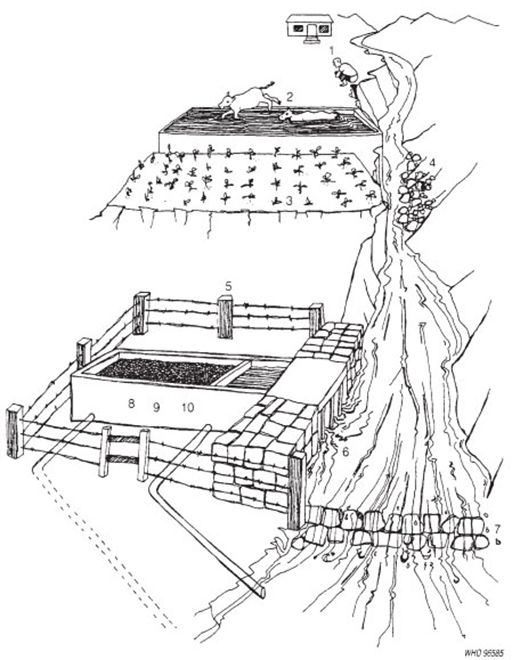
Box 12.1 Example checklist for inspection of an abstraction point at a river
- Is there any human habitation upstream, polluting the source? Yes/No
- Are there any farm animals upstream, polluting the source? Yes/No
- Is there any crop production or industrial pollution upstream? Yes/No
- Is there a risk of landslide or mudflow (caused by deforestation) in the catchment area? Yes/No
- Is the intake installation unfenced? Yes/No
- Is the intake unscreened? Yes/No
- Does the abstraction point lack a device such as a dam so that water flows into the box at 8? Yes/No
- Does the system require a sand or gravel filter because the water is silt-laden and can affect water treatment? Yes/No
- If there is a filter, is it functioning badly? Yes/No
- Is the flow uncontrolled? Yes/No
Total number of ‘Yes’ answers = contamination risk score:
9–10 = very high
6–8 = high
3–5 = intermediate
0–2 = low.
Name ______________________
Signature ______________________
Date ______________________
12.3 Sanitary inspection of rainwater collection and storage
As you learned in Study Session 3, rainwater harvesting is appropriate for areas that have a shortage of water sources. It is also practised in urban areas in institutions such as health centres and schools, and in domestic dwellings. While rainwater can be collected through ground catchments and stored in ponds or sand dams (see Section 3.5, in Study Session 3), here you will focus on sanitary inspections of roof catchments.
Rainwater is usually clean, unless the air is polluted by particles or chemicals, which can contaminate the rainwater. These contaminants may be unimportant, however, if the rainwater is used for purposes other than drinking or cooking.
What uses might there be for rainwater in towns, other than for drinking or cooking?
House cleaning, utensil cleaning, vehicle cleaning, washing clothes, bathing and watering plants.
The roof from which rain is collected should be free from contaminants. There also needs to be a clean and well-constructed tank, with no cracks in the sides and an inspection hole with a cover. Figure 12.2 shows what you should look for if you are carrying out a sanitary inspection of rainwater collection, and Box 12.2 has a list of questions to be asked. As before, the numbers in the diagram demonstrate particular points and correspond to the checklist of questions in the box.
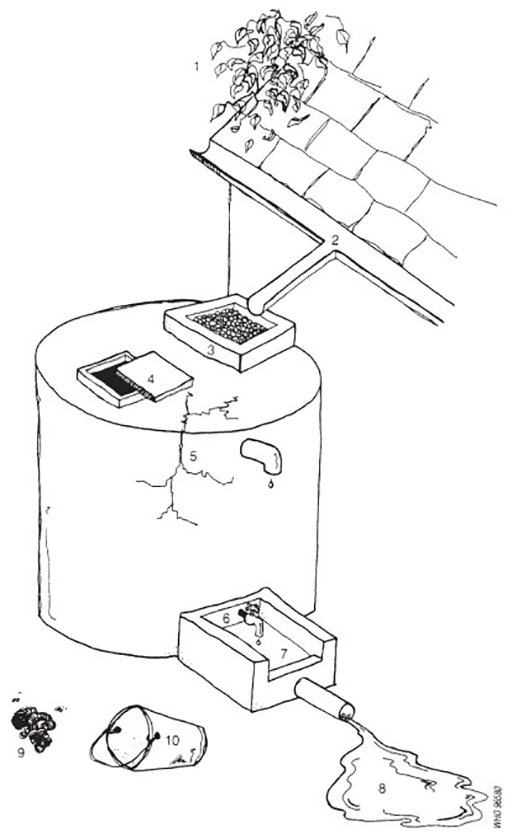
Box 12.2 Sample checklist for inspection of rainwater collection and storage
Questions to be asked during the inspection:
- Does the roof have any visible contaminants (plants, dirt or excreta)? Yes/No
- Are the guttering channels that collect the water dirty? Yes/No
- Does the filter box at the tank inlet have any defects that could let in fine dust? Yes/No
- Does the tank have any other point of entry that is not properly covered? Yes/No
- Do the walls or top of the tank have cracks or holes that could let water in? Yes/No
- Does the tap leak or have any defects? Yes/No
- Does the concrete floor under the tap have any defects? Yes/No
- Does the water collection area drain inadequately? Yes/No
- Does the area around the tank or water container have any source of pollution, such as faeces? Yes/No
- If a bucket is in use and left in place, is it exposed to contamination? Yes/No
Total number of ‘Yes’ answers = contamination risk score:
9–10 = very high
6–8 = high
3–5 = intermediate
0–2 = low.
Name ______________________
Signature ______________________
Date ______________________
12.4 Sanitary inspection of the home
Good-quality water can be supplied by water utilities but there is potential for the water to become contaminated by the user through using unclean water vessels for collection of the water, and poor handling (for example, by not storing the water carefully, and using contaminated containers to take water from the storage vessel).
What are the characteristics of a good water storage container in the home?
A container made of opaque non-degradable plastic (plastic that will not deteriorate with time); with a maximum capacity of 25 litres; with handles and a flat bottom, for easy carriage and storage; with a screw-cap; and fitted with a tap.
As you know, water is said to be safe to drink when it is free from pathogens and from physical and chemical contaminants. This needs to apply right up to the point when the water is ingested. Identifying and assessing the potential risks associated with the collection and use of water is therefore a very important part of the inspection.
If you were conducting a sanitary inspection, you would need to ask users or observe their practice on:
- how they collect the water (Figure 12.3) and the types of vessel they use (for example, jerrycans, buckets or pots)
- how the vessels are handled and stored when not in use
- whether the vessels are used for purposes other than water collection that may contaminate them
- whether users know how to collect safe water and keep it safe
- whether the water is treated or disinfected after collection
- hygiene practices of users (especially those of young children).
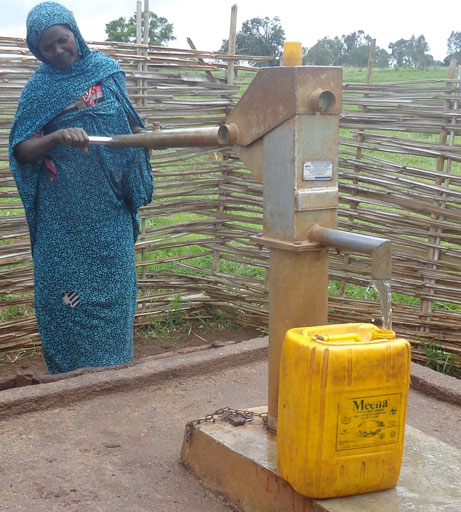
12.5 Solving problems found during sanitary inspections
Any issues regarding water safety found by the sanitary technician should be reported to the District Water Surveillance Coordinator or equivalent, who will verify the situation and may undertake further investigation before referring the matter, with recommendations, to the person more senior to them in the hierarchy. They might then liaise with others to decide on the remedial action needed to overcome the problem.
12.6 Water sampling
It is important that the water that people drink is safe. Ethiopia has drinking water standards with limits for microbial, physical and chemical parameters, and you learned about these in Study Session 9. The water utilities are responsible for monitoring the quality of drinking water.
To check that drinking water quality is within standards, samples have to be carefully taken for analysis. It is important that representative samples are obtained so that they reflect an accurate assessment of the condition of the source. ‘Representative’ here means that the water sample taken represents as accurately as possible the water supply as a whole.
When water samples are collected for analysis, care should be taken to ensure that there is no external contamination of the samples. Glass bottles, rather than plastic, are best used for sampling. Both bottles and stoppers (caps) must be sterilised (to kill any micro-organisms present) so that microbiological analysis of the water sample is valid. Bottles should be clearly labelled with the place where the sample was taken and the date. A suggested form to accompany the water sample is shown in Figure 12.4. Note that residual chlorine is measured on site.
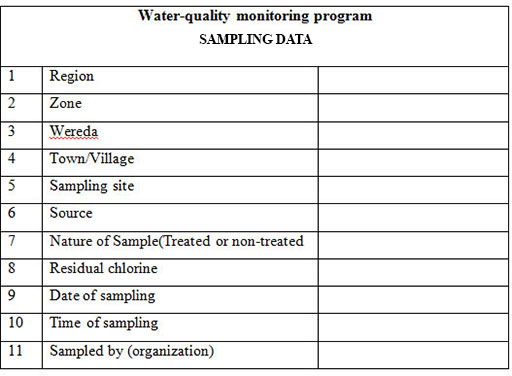
Details of the sample (time taken, location, etc.) and results of any measurements made should be carefully recorded and filed, so that they can be referred to later if needed.
You will now consider the sampling procedure for two different locations.
12.6.1 Procedure for sampling from a tap or pump outlet
To obtain a representative sample of water, the sampling procedure described below and illustrated in Figure 12.5 should be followed. The steps are:
- Clean the tap/outlet using a clean cloth to remove any dirt.
- Turn on the tap and let the water run at maximum flow for 1 to 2 minutes; then turn it off.
- Sterilise the tap outlet for a minute with the flame from a cigarette lighter or an ignited alcohol-soaked cotton-wool swab.
- Turn on the tap again and allow the water to flow for 1 to 2 minutes at a medium flow rate.
- Open a sterilised bottle by carefully unscrewing the cap.
- Immediately hold the bottle under the water jet and fill.
- While filling the bottle, hold the cap face downwards to prevent entry of dust, which may contaminate the sample.
- Screw on the cap. A small air space should be left so that the contents can be shaken more easily before analysis.
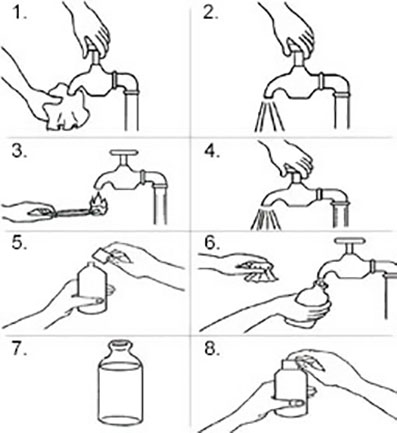
12.6.2 Procedure for sampling from a watercourse or reservoir
For towns and cities it is common for the water source to be a river or a reservoir, due to the large quantity of water needed each day by the population. Samples from the water source will be analysed using the following parameters:
- temperature, which can affect dissolved oxygen content and treatment
- dissolved oxygen, to determine if the water has oxygen and thus is devoid of undesirable products from anaerobic processes
- colour and odour, for acceptability to consumers
- turbidity, to determine if pre-treatment of the water is necessary
- suspended solids, to ascertain the level of treatment needed
- pH, to see if adjustment is needed
- organic compounds, metals and nitrate to determine if unacceptable levels of pollutants are present
- coliforms and pathogens, to determine the level of treatment required
- phytoplankton, to determine if removal is needed to eliminate odour and taste problems.
Phytoplankton are microscopic plants and other photosynthetic organisms that live in water.
The steps for water sampling are as follows:
- Open the sterilised bottle as described above.
- Fill the bottle by holding it by the lower part and submerging it to a depth of about 20 cm, with the mouth facing slightly upwards. If there is a current, the mouth of the bottle should face towards it (Figure 12.6).
- The bottle should then be capped.
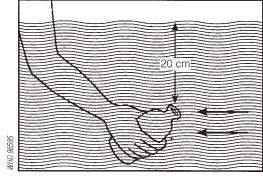
12.7 Enforcement of regulations
The water utilities regularly analyse the quality of water emerging from treatment plants, and the water in the distribution system and at public and private taps. They also undertake analyses and carry out an investigation whenever there is a complaint from a customer or a government body.
In addition to the water sampling and analyses described above, the Food, Medicine and Health Care Administration and Control Authority (FMHACA) analyses water samples from service reservoirs and at public taps, and undertakes investigations of poor water quality. If quality is found to be poor, the FMHACA sends a Notification to the water utility, which must report back to the FMHACA on the remedial measures it has applied to overcome the problem.
The Ethiopian Public Health Institute and its Regional Public Health Laboratories are available for public and private bodies that wish to have water samples analysed. Typically, WoredaHealth Offices would send water samples to their Regional Public Health Laboratory if a complaint about quality is received. The Laboratory will investigate the complaint, and recommend remedial measures that should be taken.
Summary of Study Session 12
In Study Session 12, you have learned that:
- Sanitary inspections play a major role in the prevention of contamination in water supply systems.
- Sanitary inspections begin at the source of the water. Preventing source water contamination is the most effective means of preventing contaminants from reaching consumers.
- Source water quality and conditions around the water source are the key elements of a sanitary inspection.
- Sanitary inspections include identifying and assessing the risks associated with collection and use of the water.
- They also include assessment of water management in the home, and ensure that household practices do not allow contamination to occur.
- There are specified procedures to follow when taking a water sample for analysis to ensure the sample is representative.
- Drinking water quality is monitored by the water utilities that produce the water. In addition, the Food, Medicine and Health Care Administration and Control Authority also analyses the water.
- The Ethiopian Public Health Institute (and its Regional Public Health Laboratories) analyse water samples in cases of complaints, and recommend remedial measures to overcome any issues.
Self-Assessment Questions (SAQs) for Study Session 12
Now that you have completed this study session, you can assess how well you have achieved its Learning Outcomes by answering these questions.
SAQ 12.1 (tests Learning Outcome 12.1)
Match the following words to their correct definitions.
Using the following two lists, match each numbered item with the correct letter.
sanitary inspection
phytoplankton
non-degradable plastic
representative sample
a.microscopic plants that live in water
b.plastic that does not break down over time
c.having all the characteristics of the matter that it was taken from
d.a means of identifying the pollution sources and health hazards around a water source
- 1 = d
- 2 = a
- 3 = b
- 4 = c
SAQ 12.2 (tests Learning Outcome 12.2)
You are about to set off to conduct a sanitary inspection of an abstraction point at a river.
- a.What would you take with you?
- b.Name four things you will be looking for during your inspection.
Answer
- a.You would need to take an appropriate checklist of questions to ensure that you inspect thoroughly and don’t forget anything. You will also need a notebook and pen or pencil to record all the information you collect.
- b.Important things to look for include the location of any latrines or other possible sources of contamination (due to farming or industrial activities) relative to the river, the possibility of any landslide or mudflow, a good solid fence, a screen on the intake, the presence of a dam, the presence of a filter and, if a filter is present, that it is operating properly, and whether there is any uncontrolled flow. Your answer could include any four of these or related issues.
SAQ 12.3 (tests Learning Outcome 12.3)
Obtaining a water sample that is free from external contamination is very important. Arrange the following steps so that the correct procedure for sampling from a tap is shown.
- Open a sterilised bottle carefully and hold the cap facing downwards.
- Turn on the tap half-way to maximum and let the water flow for about two minutes.
- Use a flame to sterilise the tap outlet.
- Fill the bottle nearly to the top by holding it under the water flow.
- Screw on the bottle cap.
- Remove any dirt in the tap outlet using a clean cloth.
- Turn the tap full on and let it run for about two minutes.
Answer
The correct sequence is:
- Remove any dirt in the tap outlet using a clean cloth.
- Turn the tap full on and let it run for about two minutes.
- Use a flame to sterilise the tap outlet.
- Turn on the tap half-way to maximum and let the water flow for about two minutes.
- Open a sterilised bottle carefully and hold the cap facing downwards.
- Fill the bottle nearly to the top by holding it under the water flow.
- Screw on the bottle cap.
SAQ 12.4 (tests Learning Outcome 12.4)
Ashenafi and Abrinet are really pleased to have a tap in their yard supplying treated water from their town’s water utility. However, Kuleni (Ashenafi’s mother-in-law) was a bit hesitant to use the water, since she prefers the taste of the water from an unprotected spring nearby. Ashenafi had to assure her that the quality of the water is monitored, and that they can do something in case the quality is not right. What do you think Ashenafi told her?
Answer
Ashenafi told Kuleni that the water is regularly analysed by the water utility itself to check that its quality is within standards. In addition he told her that the Food, Medicine and Health Care Administration and Control Authority also undertakes regular checks of the water quality. If there is any deterioration in water quality, Ashenafi told Kuleni that he can tell the water utility and also their Woreda Health Office. The Woreda Health Office will then ask the Regional Public Health Laboratory to investigate and recommend remedial measures. The Food, Medicine and Health Care Administration and Control Authority is also likely to notice any drop in water quality, and would also investigate the matter.